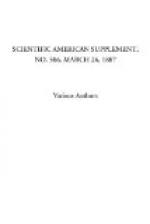By A. PUMPHREY.
[Footnote: Read before the Birmingham Photographic Society. Reported in the Photo. News.]
There can be no question that there is no plan that is so simple for producing transparencies as contact printing, but in this, as in other photographic matters, one method of work will not answer all needs. Reproduction in the camera, using daylight to illuminate the negative, enables the operator to reduce or enlarge in every direction, but the lantern is a winter instrument, and comes in for demand and use during the short days. When even the professional photographer has not enough light to get through his orders, how can the amateur get the needed daylight if photography be only the pursuit in spare time? Besides, there are days in our large towns when what daylight there is is so yellow from smoke or fog as to have little actinic power. These considerations and needs have led me to experiment and test what can be done with artificial light, and I think I have made the way clear for actual work without further experiment. I have not been able by any arrangement of reflected light to get power enough to print negatives of the ordinary density, and have only succeeded by causing the light to be equally dispersed over the negative by a lens as used in the optical lantern, but the arrangements required are somewhat different to that of the enlarging lantern.
The following is the plan by which I have succeeded best in the production of transparencies:
[Illustration]
B is a lamp with a circular wick, which burns petroleum and gives a good body of light.
C is a frame for holding the negative, on the opposite side of which is a double convex lens facing the light.
D is the camera and lens.
All these must be placed in a line, so that the best part of the light, the center of the condenser, and the lens are of equal height.
The method of working is as follows: The lamp, B, is placed at such a distance from the condenser that the rays come to a focus and enter the lens; the negative is then placed in the frame, the focus obtained, and the size of reduction adjusted by moving the camera nearer to or further from the condenser and negative. In doing this no attention need be paid to the light properly covering the field, as that cannot be adjusted while the negative is in its place. When the size and focus are obtained, remove the negative, and carefully move the lamp till it illuminates the ground glass equally all over, by a disk of light free from color.
The negative can then be replaced, and no further adjustment will be needed for any further reproduction of the same size.
There is one point that requires attention: The lens used in the camera should be a doublet of about 6 inch focus (in reproducing 81/2 x 61/2 or smaller sizes), and the stop used must not be a very small one, not less than 1/2 inch diameter. If a smaller stop is used, an even disk of light is not obtained, but ample definition is obtainable with the size stop mentioned.




